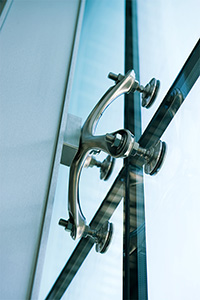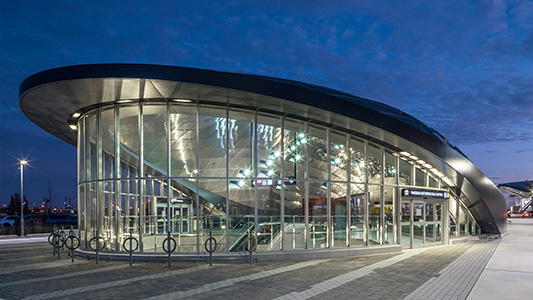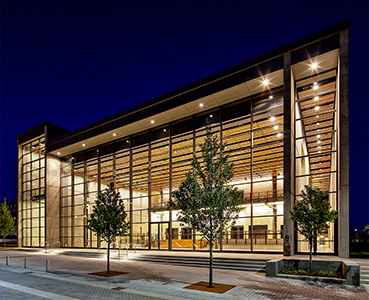Here’s what you need to know about steel curtain wall systems to get started on your next project.


Gone are the days where every building conformed to completely vertical lines. Today’s advanced steel curtain walls can accommodate these contemporary design sensibilities. They can be used to create angles, slopes and achieve great free spans, creating truly dramatic results.
A curved curtain wall aesthetic can be achieved by using steel mullions to create a segmented curtain wall system. Typically with standard steel systems the degree of turn is limited to a maximum of 10 to 12 degrees at any single mullion, while larger turning angles require variations on extruded aluminum cover caps or glazing adaptors and gaskets. With custom modern steel systems, design teams can have a greater degree of turn to achieve a tighter radius.
Design professionals wishing to achieve a seamless, “frame-free” look on the exterior side can use structural silicone glazed (SSG) steel curtain wall systems (see SteelBuilt Curtainwall® SSG System). These systems eliminate the need for pressure plates on either two sides or all four sides. They use silicone to support the “free” or uncaptured glass lite’s edges via other strategies, such as with a cassette / toggle system. The latter is a beneficial solution since most silicone manufacturers do not permit adhesion to carbon steel profiles for structural silicone applications. Steel SSG systems require a face gasket applied to the steel framing, which ensures a two-line air- and water-defense strategy. Notably, the gasket, if the structural silicone were applied directly between glass and steel profiles, would short-circuit that 2-line defense and allow water contact with the steel inside the glazing pocket, potentially leading to corrosion.
Fully- or partially captured systems, regardless of the number of sides encapsulated, have a snap-on cover to conceal pressure plate screws, creating a sleek, modern look, much like their aluminum counterparts.
Steel framing is also compatible with point-supported glazing systems. In these assemblies, steel mullions function as the structural component. The glass is supported by custom connectors (i.e. ‘spiders’), which in turn structurally attach to the steel supporting member. This helps ensure the structural component has a narrow sightline and a smooth, monolithic exterior.

Every year, curtain walls continue to soar higher, form angles that are more challenging and push the building envelope closer towards total transparency. Here’s a look at popular trends that are allowing architects to reimagine these design-forward systems.
More glass
Glass manufacturers, from float line to fabrication operations, are able to create larger lites (often referred to as “jumbo” lites), incorporating many of the features of the past. From thermal shading, Low-E and reflective coatings to heat treating and lamination, they can combine them into all aspects of insulating glass unit (IGU) production. Floor-to-ceiling glass sizes are now the bottom of the spectrum of the glass that can be accommodated in these steel systems, creating even greater soaring free spans of glass in today’s curtain wall and window assemblies. The benefits of these large expanses of glass are daylighting and clear views to the outdoors, which lend to helping architects achieve LEED requirements.
Curtain walls of the past were often only 13 feet tall, now it is not uncommon to see more than 14 feet or higher ceilings. Glass is also getting thicker to meet deflection limits and aid in its ability to meet higher wind loads for the increased area of individual lites. Some builders are even pushing the envelope through the strength of steel framing in curtain walls to use larger pieces of glass.
Less Framing

With the rise of new-generation steel curtain wall framing, a building can now handle approximately 40-foot free spans in a single member without splicing, additional internal reinforcement, or more frequent connections to the building structure. This helps provide uninhibited sightlines into and out of the building and requires less framing. Additionally, since steel framing is three times stronger than aluminum assemblies, its profile size can be nearly two-thirds that of a comparable aluminum profile while still meeting the same curtain wall performance criteria. This helps to shift viewers focus off the frames and onto the glass and what is behind it.
Complex Framing
Individual glass lites no longer need to be limited to rectangles. Because of the production efficiencies realized by modern fabrication methodologies, the use of trapezoidal, parallelogram, or triangular lites (or other “patterned” glass shapes) can be easily framed by steel systems.
Electrochromic Glass
Electrochromic glass is smart-technology glass that automatically tints in response to the outdoor climate and lighting conditions. This helps occupants inside the building enjoy a comfortable, well-lit interior. Electrochromic glass is becoming more popular as green requirements get more stringent. The glass can be used on curtain walls to create long-term savings that include the glass’ potential to cut back energy costs by blocking unwanted solar energy and / or glare. With this glass, occupants don’t need blinds or shades because the glass does the shading adjustment automatically for them.